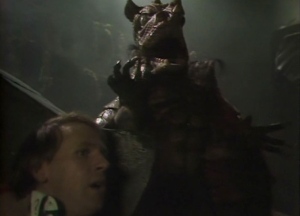Sometimes you need to take a break to recharge your creative batteries. After more than twenty years on the air, Doctor Who takes its first “hiatus”, coming back fresh after an eighteen month gap. Colin Baker returns, along with his scary smiling face in the title sequence, but the music has been changed to a more subdued and bassy version of the theme. Season 23 has one further change: the entire season is one story arc, encompassing multiple stories that tie into a narrative framing device, namely a courtroom trial. The Doctor is facing charges from his own people, for meddling in the affairs of others. Past attempts to bring together multiple writers’ stories into an arc have not been successful, so I remain sceptical for now.

The Time Lord courtroom. Surely putting the screen BEHIND everyone is just going to cause neck aches, no?
Things certainly get off to a good start, as the story opens with the single most ambitious visual effect the show has ever attempted so far. A fantastically complex motion-controlled sequence sees a Time Lord space vessel pull the Doctor’s Tardis into its glowing tractor beam hatch, the camera swerving and swooping around to cinematically capture the event. It’s seriously impressive. Sadly, that’s where most of the budget went, as the rest of the story is set within the usual low-budget BBC sets or out in a forest, and film has been swapped for cheaper outdoor video again. Oh well!

The incredible opening sequence is not just technically accomplished, it’s superbly composed too.
The courtroom side of the story has the Doctor face off against his prosecutor, the Valeyard. As you would expect, he doesn’t take the situation seriously, and gets increasingly irrate. This is actually quite a suitable situation for this version of the Doctor and provides some comedic moments (“I object!” “What now?” “Yes, now!”) and some epic rants. All the while, the court is watching one of the Doctor’s adventures on the screen, set on a mysterious planet that closely resembles Earth…

Seeing the remains of Marble Arch underground station, Peri is understandably upset at seeing what Earth will eventually become. The Doctor merely sees it as a statistic. All worlds come to an end eventually.
Well, it’s two billion years in the future and Earth isn’t where it’s supposed to be; in fact, the Doctor confuses it for planet Ravolox. Something is going on here but it’s a mystery for another time. The story features a fairly typical social dichotomy setup, with a primitive tribe above ground and the technologically advanced society sealed below. In a classic role reversal, the poor humans down there are slaves to their robot “god” and the Doctor has to lecture it about the value of life, which it obviously fails to grasp.

The Doctor confronts the robot, Drathro.
There are certain similarities with Robert Holmes’ first Doctor Who script, The Krotons, which is fitting as this was his last one before he sadly died the following year. He has undoubtedly made some of the best contributions to this show over the years, and this remains evident even in his final story. Take the two mercenaries, Glitz and Dibber. Another writer might have ignored any characterisation of two fairly inconsequential characters, but Holmes fleshes out his villains with quirks, gives them humour and personality that breathes such fun into their scenes that I was actually glad that they got away at the end.

Glitz and Dibber plan to breach the control room.
Where the writing kind of fails is where it uses wishy washy space terms without much thought. Glitz and Dibber are from “the constellation of Andromeda”, apparently. Now, let’s ignore for a moment the fact that you can’t strictly be “from” a constellation, since it’s merely a representation of many stellar bodies as seen from Earth; one such body would be the Andromeda galaxy, which is such an astronomical distance from our own that it renders any interest in Earth trivial. These two characters noticing that Earth is a couple of lightyears off of its position is, to put this into perspective, like somebody in Australia noticing that a grain of sand on Brighton beach has moved a couple of millimetres to the left. A couple of lightyears isn’t even as far as Earth’s nearest star, Promixa Centauri! Where is this mysterious planet getting its sunlight from?!
Anyway, niggles aside, I thought the Mysterious Planet was rather good. I’m certainly intrigued by the courtroom side of things, but I found the actual story presented to be strong in its own right. We’re off to a good start, let’s hope it continues.








































